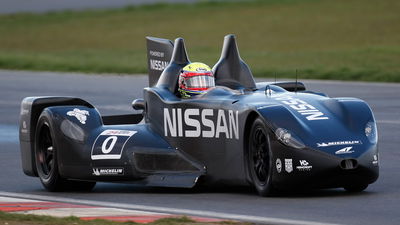The Alfa Romeo Pandion Was A V8 Concept With The Most Incredible Doors

A few days ago we were looking at the Dodge Viper-based Alfa Romeo TZ3 Stradale Zagato. It was intended as a celebration of Alfa’s centenary, but that wasn’t the only car to mark the occasion.
Bertone also produced a 100th birthday present for Alfa Romeo, but it trod a very different path. Despite Zagato’s rival Italian design house having a back-catalogue chock full of Alfa collaborations dating back to the 1950s, it instead looked to the future with the Pandion.

Taking its title from the scientific name for the osprey and also taking design inspiration from birds of prey, the Pandion was first shown to the world at the 2010 Geneva Motor Show. A process called ‘random form generation’ shaped much of the Pandion’s aesthetic, with the designers - led by then-Bertone design boss Michael Vernon Robinson - inputting “algorithms from nature” into a computer.
Out the other end came randomly-generated, more organic structures than something a human designer might come up with. From the gloss white latticework that flowed through the car’s internal ‘spine’ to the festooning of crisscrossing blades in the back, the Pandion was awash with strange and brilliant details.

And yet, all of that stuff played second fiddle to one particular detail: the doors. Hinging at the rear of the car and stretching all the way along its length - front wings and all - the doors opened at a 90 degree angle and stretched 3.6 metres in the air. It’s not a car for your average multi-storey, in other words.
Under the skin, it was more a Maserati as opposed to an Alfa Romeo, using the Gran Turismo-related 8C Competizione as a starting point. The wheelbase grew slightly, and it was lower (with the doors closed, at least), longer and wider over all.

The 8C’s Ferrari-built F136 wet-sumped, crossplane-crank V8 was retained, sending 444bhp to the rear wheels. With a whole load of carbonfibre used in its construction and no need to worry about road legality, the Pandion ended up being a lot lighter than the 8C, with a kerb weight of 1258kg, making for decent performance (by 2020 standards) considering the ‘modest’ output. 0-62mph happened in just under four seconds, and its top speed was around 200mph.
These aren’t theoretical figures, either. The concept was fully functional, and actually passed into private ownership. It most recently changed hands at an auction in Milan in 2018 for €570,000.

Away from the Pandion’s futurism and back to reality, the time that followed its reveal wasn’t the rosiest for Alfa Romeo. The 8C halo car departed in 2010 along with the overweight but alluring Brera, and the 159 followed a year after. The firm’s line-up consisted only the not-terribly-good Giulietta and the really-not-terribly-good MiTo for some time before Alfa baffled the world with the gorgeous but dynamically flawed carbon-tubbed 4C.
Just when things looked to be getting back on track with the Giulia, the Stelvio, plus talk of all-new versions of the GTV and 8C, FCA decided to massively scale-back Alfa’s rebirth by ditching the latter two vehicles. Just a few months later, our disappointment was eased by the reveal of the utterly bonkers 533bhp Giulia GTAm, the Italian brand’s self-gifted 110th birthday present.

That’s the way of Alfa Romeo, isn’t it? It wouldn’t be the company we know and love without it ricocheting between triumph and disaster. From the high points of concepts like the Pandion to the lows of sub-par hatchbacks and back to the highs again with the Giulia Quadrifoglio or GTAm, the Alfa Romeo story will never, ever be boring.















Comments
Anybody else seeing a crab saying “YAAAAY” in that thing?
well now that you point it out
The blades in the back make me incredibly anxious one is going to snap off
rly looking forward to seeing someone trying to open it inside a garage